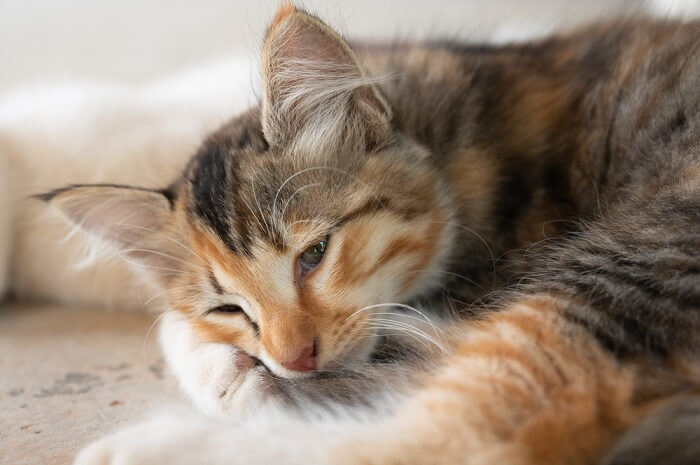
Mirtazapine is a prescription appetite stimulant commonly used in veterinary medicine for cats to encourage interest in food, eating, and to encourage weight gain.
Brands include Remeron and Mirataz. In this article, you’ll learn what mirtazapine is, how it works, different dosage forms available, potential side effects to monitor for, and some commonly asked questions.
Mirtazapine for Cats Overview

About Mirtazapine for Cats
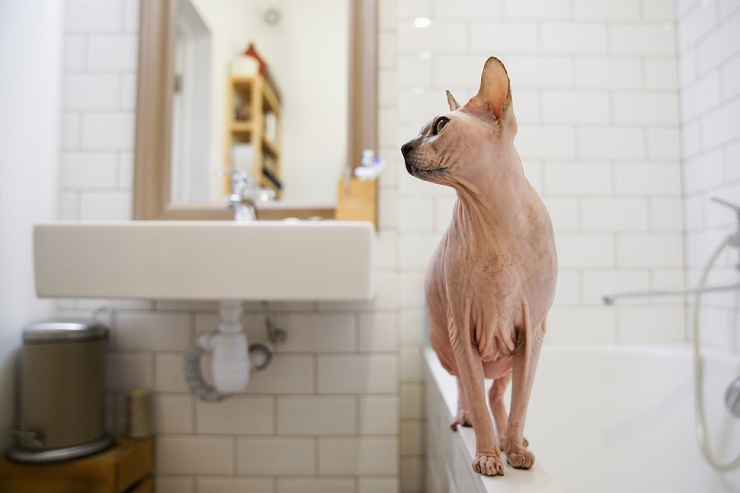
Mirtazapine is classified as a serotonin receptor antagonist and a tetracyclic antidepressant. However, in cats it is not used as a behavioral medication, but more for its benefits for encouraging appetite and eating.
Norepinephrine (NE) is a neurotransmitter which, among many other roles, does act at certain receptors in the body to increase appetite. Mirtazapine is thought to block receptors that would stop NE’s release. This leads to an increase in NE, and a subsequent increase in appetite.
Mirtazapine also blocks serotonin receptors. By blocking certain serotonin receptors, mirtazapine also provides an antinausea and antiemetic (anti-vomiting) effect.
Currently, mirtazapine is available commercially as a generic tablet, as well as the topical transdermal brand Mirataz, which is applied to the skin of the inner surface of the ear flap.
What Does Mirtazapine Do for Cats?
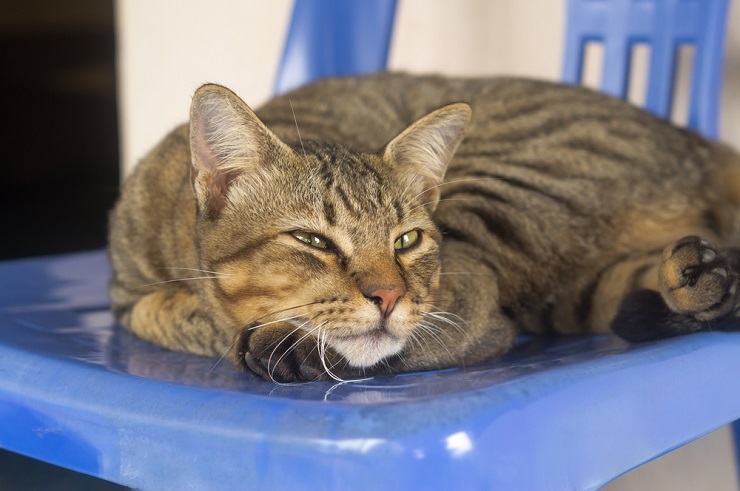
Mirtazapine has been used for many years by veterinarians to aid in stimulation of appetite for cats. This may apply to cats with poor appetites, such as kitties with chronic kidney disease (CKD), or cats with other conditions causing weight loss where we want to encourage more calorie intake.
Side Effects of Mirtazapine for Cats
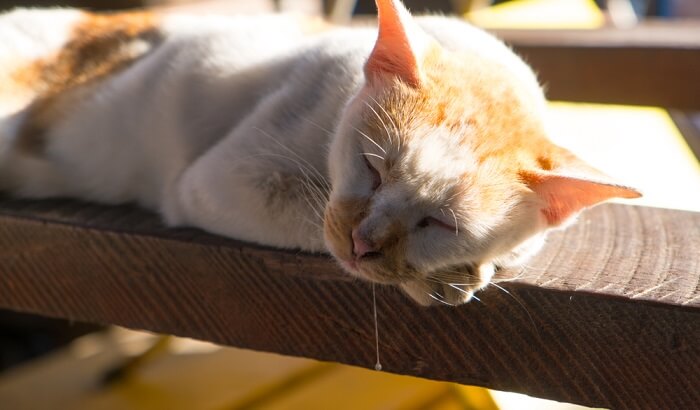
Mirtazapine can cause hypersalivation (drooling) and sedation (excessive sleepiness) in cats.
Mirtazapine is a generally well-tolerated medication in cats, but there are some adverse effects to be aware of and monitor for.
Because mirtazapine does also act as a histamine blocker, sedation may be noted, especially at higher doses.
The next most common side effect is increased vocalization, seen in about 50% of cats. Agitation and gastrointestinal effects like vomiting may be seen in about 25% to 33% of cats.
Abnormal walking, restlessness/hyperactivity, and hypersalivation (drooling) may be seen in just over 10% of cats. Remaining side effects, which affect just about 10% or less of cats, may include increased breathing and heart rate, poor appetite, disorientation, inappropriate elimination, tremors/shaking, and hiding behavior, among others.
Studies looking at mirtazapine use in cats have noted fewer adverse effects when lower doses are used.
For the topical brand Mirataz specifically, about 10% of cats may experience reactions at the site of application on the inner surface of the ear pinna. This can include but is not limited to redness, crusting, scabbing, and residue build-up.
Of reports to the ASPCA Animal Poison Control Center, the most common signs seen in the event of an overdose included excessive vocalizing, agitation, and vomiting. Fortunately, at least in humans, doses upwards of 10 to 30 times the prescribed dose exhibited minimal toxicity, requiring only several hours of observation.
Mirtazapine can interact with a variety of different medications, especially sedatives, pain medications, and medications used to modify behavior. Always make sure to discuss any medications your kitty may be taking with your veterinarian if mirtazapine use is being recommended or prescribed.
Mirtazapine should be used carefully in pets with kidney disease, liver disease, heart disease, or diabetes mellitus. Mirtazpine is used commonly with some of these conditions lending to their impact on appetite, but doses may need to be lower and more carefully monitored.
If you are ever concerned that your kitty may have developed side effects while using mirtazapine, make sure to contact your veterinarian, the ASPCA Animal Poison Control Center (1-888-426-4435), or Pet Poison Helpline (1-855-764-7661) for further advice.
Mirtazapine for Cats Dosage
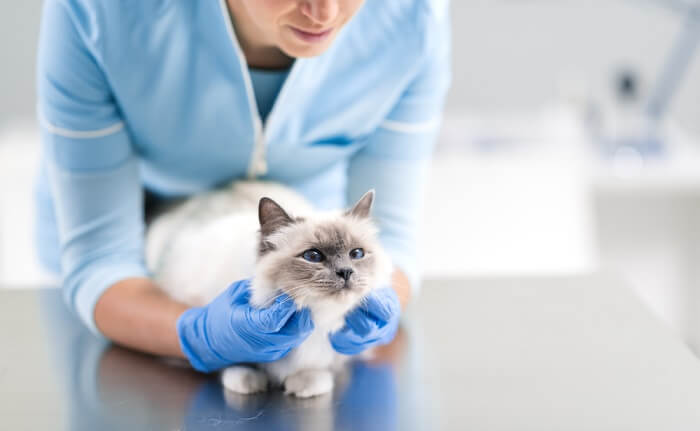
Your veterinarian will recommend the ideal dosage and dosing frequency based on your cat’s individual needs.
The dose for the tablet form of mirtazapine may range from about 2 milligrams up to 3.75 milligrams, depending on goals and tolerance of side effects. The generic tablets only come in two sizes of 7.5 milligrams and 15 milligrams.
Dosing frequency for the oral tablets may only be required once every 48 to 72 hours, but a cat’s appetite should be carefully monitored to determine the best dosing interval.
As the proper dose and frequency may depend greatly on your cat’s needs and any current health conditions, always make sure to discuss mirtazapine dosing for your kitty with your veterinarian first, including current and past health conditions.
The topical product Mirataz, which is a mirtazapine transdermal ointment FDA approved to manage weight loss in cats, has a labeled dose of a 1.5-inch ribbon of the ointment applied to the inner pinna (flap) of the ear once every 24 hours for 14 days. This equates to a dose of about 2 milligrams.
With Mirataz, it is extremely important for the person applying the product to wear gloves to prevent absorption of the product on their own skin. Proper application of the product to the inner surface of the ear pinna is best done using a thumb or forefinger, but as a transdermal product, the medication could be absorbed through the skin of the person applying the product.
Although mirtazapine is also a medication sometimes used in people, accidental absorption of the product should still be avoided.
Conclusion
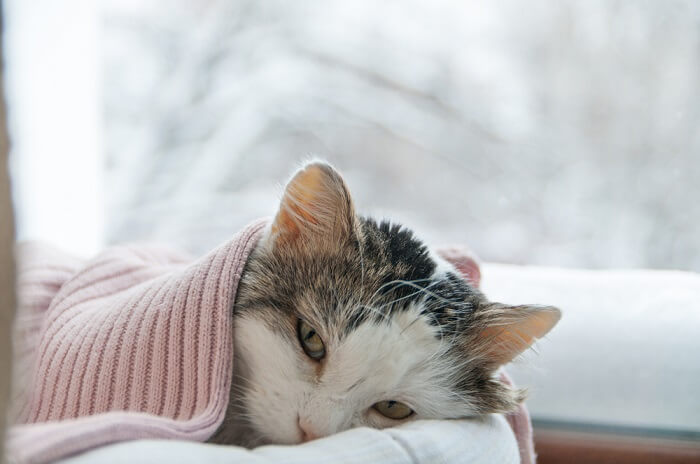
Mirtazapine can be a great medication to help support kitties suffering from weight loss or a poor appetite. The topical brand Mirataz can also provide a welcome route of dosing a medication to a kitty already not eating well or difficult to give oral medication to.
Mirtazapine can exhibit some side effects due to its activity as an antidepressant. However, in a majority of cats, especially those given lower doses, mirtazapine is often well-tolerated and a very useful therapeutic medication.
Frequently Asked Questions
What does mirtazapine do for cats?
Mirtazapine is a type of appetite stimulant medication. It is most often used in cats suffering from a short-term or long-term decrease in appetite, as well as weight loss.
How long does mirtazapine last in cats?
This generally depends on the dose and form. An oral tablet dose may last on average for about 48 hours, though in some cats it may last for less time and closer to 24 hours, while for others it may last up to 72 hours.
Does mirtazapine make cats sleepy?
Because one of mirtazapine’s actions is to act as a histamine blocker, it can lead to sedative effects. This is a similar effect as other medications we think of more as antihistamines for allergies, like Benadryl. This effect of mirtazapine is often seen more when higher doses are used, such as doses closer to 3.75 milligrams or higher.
How much mirtazapine can you give a cat?
The labeled dose for the topical product Mirataz is a 1.5-inch ribbon of ointment applied to the skin of the inner pinna (flap) of the ear. This dose equates to 2 milligrams of medication.
The mirtazapine tablet doses may range from about 2 milligrams up to 3.75 milligrams commonly in cats, anywhere from every 24 to every 72 hours. Which dose is appropriate for your cat depends greatly on the condition causing poor appetite and/or weight loss, and other conditions your kitty may have.
Higher doses and increased frequency can be associated with more side effects, so it’s always extremely important to discuss dosing and frequency of mirtazapine with your vet prior to giving a dose to your cat.
How long does topical ointment need to take effect?
for the Mirataz product itself, I have usually found it to have effect on appetite within 1.5-2 hours after application in many cases. This is especially the case with repeated daily use. A first initial dose may take longer as the medication must initially get absorbed (as opposed to being replenished with repeated doses). My own expectation for a first time dose would be seeing a cat dosed in the morning eating by dinner time or a cat dosed in the evening to be interested in eating a meal the next morning. As you continue with the daily dosing, the time to seeing an effect should then be much shorter, within that 2 hour time frame. If you don't see an improvement in appetite within 12-24 hours after a first dose, I would touch base with your vet.



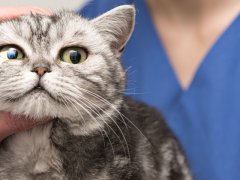
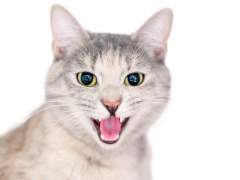



Hello There,
I’ve got a Adult Maine Coon Cat that’s 14-yrs old. Just five months ago I noticed he wasn’t eating anything at all during the day.
So I put put some solid Cat Food out for him, he either didn’t eat of it, or just a little at a time. As time when on, I begin to worry more about him. So I made an App. with my Vet, and told her the problem I was having. So my Vet gave me some Mira-
taz (“mirtazapine Transdermal Ointment”) 5g. small tube. I’ put this on the back of my Cat’s back Upper Pinna of his Ear, once
daily. To help him with his appetite. This (“Mirataz”) came with a package insert, and this drug finely worked. I was so gad about this. Ill give it to you again, I just
love my “Cat”, I don’t know what I’d do without him.
So sorry to hear your kitty isn’t feeling well, Michael! I’ve used Mirataz with one of my cats and it seems to work well. Hope it does the same with your cat! My “solid cat food” I assume you mean pate? Some cats can be picky about texture, so you might consider trying a recipe with meaty bits and gravy or broth. My cat showed absolutely no desire to eat until I brought out a particularly smelly pouch of fish-based cat food. I’d recommend buying a few different types of cat food pouches to see if you can find one your kitty will eat. That paired with the Mirataz will hopefully help him gain his appetite back!
Hello, how fast did Mirataz work with your cat? I started applying it last evening, After 2 hours I heard him eating dry food, but that was all. He is lethargic, cries when I take him in my arms, makes unpleasant noises and spits on me… He has severe anemia and I really need to make him eat! Please help with any advice, I’m so sad to see him fading away… (2 years old at the end of the month). Thank you!
our cat has basically just stopped eating , has been given this stimulant by vet to have every 48 hours but its not helping.
have bought many different foods but no luck. Blood tests say he is fine but a tad anemic . Not sure what else to try
Hi Elle,
Sorry to hear about your kitty. There is another appetite stimulant that is approved for use in cats that you could ask your vet about called Elura (capromorelin). However, mirtazapine usually has at least some positive effect in many cases. If your cat is still not eating, further diagnostic testing may need to be considered to determine what the underlying cause of the anorexia is. Consider asking your vet about other testing options available including x-rays and ultrasound, if these haven’t come up yet. Other supportive care medications beyond just appetite stimulants may also be needed, depending on the underlying issue that is affecting appetite.
Thank you for the reply.
The vet has redone bloods, x-rayed and parasite test to no avail.
Cat has taken to licking my chiminea, we are wondering if the loss of our other 3 pets
this year due to old age and cancers and the introduction of a new puppy may be his issue
My cat started severe bleeding from the eyes after getting the ribbon of Mirataz on the inner pena of the ear. Did not see a specific warning for this. My cat has not eaten any wet Pate cat food or dry food, and has been losing weight. Be careful using. I hope no one else has this problem. My 11 year old cat also has kidneys which are in decline. Poor kitty.
Hi Rudy, this is an unusual thing to see happen and has not been reported with mirtazapine use in any studies to my knowledge, even in the list of very rare effects. I was not clear if this is bleeding within the eyes that took place or if it was actual blood being seen on the face thought to originate from the eyes. Either way, something like this is more likely to be occurring because of another underlying condition, such as hypertension in the case of bleeding within the eyes (which could be seen associated with kidney disease), or a blood/clotting disorder in the case of the latter. I would generally be more concerned that an underlying cause of your kitty’s poor appetite and weight loss would be responsible (which could be kidney disease depending on how advanced it is vs. an additional condition) vs. the mirtazapine alone.
Test for histoplasmosis. My cat had these symptoms of decreased appetite, lethargy, looking disheveled, weight loss, anemia, inflammation in the blood work. They kept trying to diagnose him with cancer and wasted a lot of time and money…
What happens to Mirataz after 30 days? The pkg says to disgard after 30 days. My vet told me that I could use it on an as-needed basis and it does work for a few days after one dose. Does Mirataz lose effectiveness or something more serious. My cat will be 19 in April and has some kidney disease. Thank you.
Hi Barbara,
This is a good question, but not one that there appears to be a simple answer for. The drug insert does not contain any supportive info on why Mirataz should be discarded after 30 days. My best guess would be that either the drug or the ointment carrier lose their stability and effectiveness after 30 days of the package being opened and exposure. It may be possible that the drug is simply less effective at being absorbed properly after that time.
My cat has been diagnosed with pancreatitis. He has virually stopped eating. He has had x-rays, ultrasound, blood work and fluids. Everything is normal except his pancreas. It came on very suddenly. He is home now taking cerenia, prednisolone, and mirataz. The mirataz does not seem to be working. He was on it 5 year s ago for another reason, and it worked great (within hours). It is sunday, of course, so my vet’s office is closesd.
Hi Sandra,
Anorexia, or absence of appetite, is a primary sign of many cats with pancreatitis. Unfortunately, the severity of pancreatitis can vary quite a lot with some cats able to be treated with some outpatient supportive care, while others need to be hospitalized to help with recovery. An appetite stimulant can be helpful because we do want these kitties eating as soon as possible, but the severity of the disease can overcome the drug’s capabilities sometimes and successful treatment requires continually addressing the other challenges like pain management, inflammation, suppressing nausea, and providing fluid/hydration support. I hope you were able to seek further care and that your kitty has shown some signs of improvement.
For years, one of our cats, Alice, had problems with eating at times. She was diagnosed with upper reporatory illness, which would come and go. Lysine chews helped some, but not that much. We would try everything to get her to eat, usually with little success. About 5 1/2 years ago, she went into serious decline, and we thought we were going to lose her. After many tests, and hospitalizations, blood work suggested possible pancreatitus, although no actual diagnosis was given. But, she was put on prednisone (later switched to prednisolone). The doseage was decreased over time, to 5 mg every other day, but I discovered that 1/2 tablet, 2.5 mg every day worked better. But, she still had times, lasting days when her appetite was poor. Mirtazapine was reccomended, with the doseage of 1/4 of a 15 mg tablet given once every 48 hours, but only a total 3 doses given. The side effects were scary, drooling, hiding, then loud vocalizing, demanding food. This indicated to me that the doseage was way too high. Over time, I decreased the doseage, using smaller chunks. Cutting the tablets into eighths resulted in a variety of sizes, as well as crumbs, or powder. I needed a way to administer these doses, which were small, and began using soft cheese, which worked OK, but then I discovered using a bit of white bread rolled into a ball, in a size the pill holder would take without it falling out. I put them in a warmed toaster oven to dry them, making them more pill-like. I continued decreasing the dose, while using these mini-doses, which later became micro-doses on an as-needed basis. I kept a daily log, which I still do, to keep track of her food, and medications, and anything else pertinent. Eventually, I began crushing the tablets into powder. This allowed me more accuracy, with the help of a magnifying glass, and I could give micro-doses, in two strengths, eventually settling on 1/100th (.15 mg), and 1/200th (.075 mg), which I gave her on an as-needed basis, with her prednisolone. Over time, I have had to increase the doseages somewhat, so I now make them in 1/50th (.3 mg) and 1/100th (.15 mg). I’ve also had to give it to her more frequently, and in fact now, it is most days she needs at least the smaller dose (1/100th). I suspect her condition has worsened. She had blood work done a little less than a year ago, but nothing conclusive came of it. I might have it done again, although it does seem a bit pointless. Sometimes her condition is worse, and she even vomits, so I have to give her more mirt., which is the case today. The larger doses I made up recently are actually 1/48ths, and she has had two so that is a total of 1/24th (.625 mg). That is still a very low dose, although high for her. Other than perhaps increasing the prednisolone, I don’t know what more they can do.
We were advised at one point to switch to the ointment, which costs way more, and is more of a problem administering. The reasons given were never rational. My scientifically based approach, although not perfect, was working. Her condition varies from day to day, and this gives me flexibility. We had to leave that vet when it changed hands, as the new vet refused to accept my approach, refusing to prescribe mirtazapine and demanding I use Mirataz instead. I had problems with another vet, before finding our current one who is willing to work with my approach. Unfortunately, some veterinary practices are greedy, and on power trips, and have the attitude of, “if you don’t like it, go somewhere else”.
Hi Bruce,
Thank you for sharing. Your approach to mirtazapine is unconventional but interesting and your dedication to finding out what works for your cat can’t be denied.
One quarter of the 15mg tablet has long been used as a dose for cats because the 15mg tablets are the most practical to also use in dogs, keeping one tablet size on the shelf.
1.88 mg is a recommended starting dose, but cutting those little 15 mg tablets into 1/8ths is challenging. But a ¼ of the 7.5mg tablet can work okay, which has led some practices to carry both dosage sizes so that getting the starting dose smaller for folks at home to give their cats can be easier.
The side effects you mentioned early on have certainly been reported in cats and it is known that using higher doses in cats doesn’t improve appetite more, it only increases the risk for side effects. However, I think it has often been assumed that if a cat has side effects at a typical starting dose of mirtazapine, that the medication simply cannot be used further. I don’t know that looking into doses lower than 1.88 mg has been widely studied.
It sounds like you found a way around side effects of conventional doses using the micro doses. It’s important to realize though, that these methods you’ve used may not be practical for most folks to be able to do with the degree of accuracy you describe. It is also very possible that doses that low will not work for many other cats.
This may be the basis of some of the frustrations you’ve run into in having your methods accepted. Mirtazapine tablets are not FDA approved for cats (or dogs). When using drugs off-label, which occurs a lot in veterinary medicine, veterinarians have to rely on doses and protocols that have been studied or used extensively. Even if a pet parent finds some kind of creative way of dosing a drug that works well for their personal pet, a veterinarian may have to advise against dosing it that way because it doesn’t follow medical convention. And any doctor can refuse prescribing a medication if they feel it is being used improperly by a client or patient.
No efficacy has been studied or recorded at doses so small as you’ve described, and the doctors who have objected may have done so because there’s nothing to compare that to and it may even be unclear to them if the drug is actually working at those dosages or if your cat’s condition is just waxing and waning on its own. I myself certainly could not say for sure.
Since mirtazapine tablets aren’t FDA approved, but in recent years there are now two appetite stimulants that are FDA approved for use in cats (Mirataz and Elura) and one for dogs (Entyce), many veterinary practices are phasing out mirtazapine tablets. The rationale being, why risk using a drug off-label when there is an FDA-approved alternative that has better dosing and safety studies to support it. This may be where you’re seeing the push for Mirataz. Mirataz has actually been much easier to use for many folks because pilling cats can be tough but applying a little ointment to an ear is doable. That certainly was the case with one of my own kitties.
I personally feel however that keeping the tablets in stock is useful, especially as a lower cost alternative that may work just fine for some cats.
Hopefully, that provides some insight. I’m glad you have found a veterinarian that you feel comfortable working with. I wish you luck with your kitty.
Hi – Thank you for your thoughful response. Don’t forget, I have been keeping a daily log (on computer) now for five years, including the doseages I use, and her food intake. This far and away exceeds any scientific trial. The proof that my method has worked is there, in black and white. Over time, I have had to rely a bit more on the mirtazapine. So, in the morning, along with her daily dose of prednisolone (1/2 tablet), I give her a 1/100th dose mirt. ball. This usually works well, although sometimes I need to give another dose (1/100th or sometimes 1/50th) later. It is a bit painstaking to divide the powder. It takes patience, and a steady hand.
Thanks Bruce, and again, I can’t deny the dedication to your kitty and that you feel you have found a strategy that works. But how applicable this is to the wider cat population would still be in question. A scientific trial, like a clinical trial, is going to have many more cats in it. Even if it’s for a much shorter period of time than you’ve been working on this method, the larger number of cats in a clinical trial makes the findings and results more applicable in terms of what to expect over a larger, more variable population of kitties.
Hi,
My female cat Izzie is 14 years old and just stopped eating, not much drinking, lost two pounds, lethargic and just not herself. The vet did blood work and an injection of fluids since she was dehydrated plus an injection of an antibiotic. Test came back her liver enzymes are elevated. She just started today on Denamarin 90 mg and Mirataz for appetite. I am hoping these meds work. Will her appetite increase quickly or is it a day or two? We are waiting a few weeks to see if an ultra sound is needed. What will an ultra sound show, cancer? Is there treatment for liver cancer is cats? Will I know Denamarin is working withing a week or two?
Any guidance is appreciated.
Thank you,
Sherry
Hi Sherry,
I’m sorry to hear your kitty is having a tough time. Generally, Mirataz will have a more immediate effect. In my own experience, it’s within about 3 hours. But because it may take a little time for the other therapies to help, you should check back in with your vet if there hasn’t been noticeable improvement within 2-3 days of using the Mirataz daily.
There are lots of things an ultrasound can look into if liver values are elevated on bloodwork. This is not necessarily just cancer. Cats can also have infectious or inflammatory conditions affecting the liver as well as the gall bladder. And because they are closely connected in the body, some cats will also have concurrent pancreatitis and inflammatory bowel disease at the same time. An ultrasound is one of the best ways to evaluate for all of those things to help guide therapy.
The only way to know if Denamarin is working is to recheck the liver values and see if they’ve gone down. Checking in just a week is likely too soon. It’s more common to check after about 4 weeks.
If Izzie is not feeling better with the current therapy in a day or two, it may be worth looking into the ultrasound much sooner to get a more full picture of what is involved.
Hi Dr. Vanderhoff,
Thank you for your comments; very much appreciated.
I am happy to report Izzie has responded and is acting “almost” normal. She’s eating and not lethargic any longer. She started the medicine on Friday and seemed so much better within two days. Today is a week and what a difference. I would not say 100% but she is definitely responding to the meds and eating quite a bit. Should I ween her off the appetite medicine Mirataz?
I will check in with my vet for an update on her liver levels thru bloodwork. I am hoping Izz has turned the corner and can be healthy and happy for her senior years.
Hi Sherry, very glad to hear. We will often wean off Mirataz once appetite returns to normal, as long as the underlying cause of appetite loss has been addressed. I would for sure check with your vet on the specifics of when to do that, perhaps after the recheck bloodwork has been done.
Hi Dr. Vanderhoff,
I recently took in a 16 year old foster cat, Maude, who was already on Mirataz ointment. She had lost her owner in February; had been in two previous foster homes; wasn’t eating and was hiding a lot. I was told to continue the Mirataz once every three days. The Mirataz worked wonderfully. Maude was eating and she started responding to me, asking for pets and sitting on my lap. So last week I didn’t apply the Mirataz to see where Maude was in terms of eating. For the whole week, Maude was fine. She continued to eat well and respond to me. However, this morning I went to see her and she is listless and refuses to eat. Can the Mirataz have been in her system for that long? If so, I will reapply. Thank you.
Hi Tobi,
First, koudos to you for taking in an elderly foster cat. These kitties need care and attention and often come with pre-existing health issues. It’s a noble responsibility. In answer to your question, in my own experience, Mirataz only works for about 24-36 hours. I found in my own cat that it boosted his appetite for about a day and a half. However, there really is no way it would continue working within the body for as long as a week. Sometimes, stimulating appetite may get a cat over a “hump” and they’ll maintain on their own. However, it’s hard to tell in this case what is happening, because it doesn’t sound like we know what underlying disease conditions Maude may have. The appetite changes, while attributed to anxiety and stress of relocating, may also be mixed with a physical ailment that is also affecting her. Knowing what is going on systemically, at least with some labwork, may help with management and expectations. You can also sympatomatically address the appetite with Mirataz, but it’s important to understand that you may not have the full picture of her health situation. I wish you both the best of luck.
Hello Dr, thanks so much for posting all the information and advice above. My cat is diagnosed with CKD stage 2, and we start to do Sub-Q twice a month at home. However, wiith the decreasing of appetite, I want to start using Mirtazapine, and I’ve some concerns. How often can I use this medicine, and does this medicine accelerate renal failure or make it worse? Thanks so much Dr Vanderoff!!
Hi Chris,
Any medication should be used cautiously with kidney disease, but it can depend on the stage of disease and any other concurrent illnesses or complications.
Mirtazapine is generally well-tolerated in most cats, even cats with earlier stages of kidney disease. It is a commonly used medication with many causes of poor appetite and weight loss in cats. Research has supported use of a 2mg or less dosage as having less risk of side effects. The topical Mirataz product is 2mg. The Mirataz product is typically applied daily, though appetite could be monitored after the dose to see when a follow up dose may be needed.
With oral mirtazapine, a dose may be spread out every 2-3 days, as long as appetite continues to respond.
We always try to balance the benefits of a medication with any risk of side effects. The fluids your cat is receiving is certainly helpful. Regular lab work monitoring with your vet is also important to see if any change in therapy approach is helping or hindering the state of disease.
Thanks a lot Dr Vanderhoof!! I’ll go ahead to try a low dosage of topical Mirataz,
Does anyone know if it is ok to give a cat the transdermal mirtazapine longer than 14 days?
We have a cat that keeps not eating. We’ve done the mirtazapine a couple times now and it works well.
When we stop, she goes back to not eating. We’ve run EVERY test imaginable. Everything comes back clean and healthy.
No clinical reason why she refuses to eat.
Our vet says it’s not for long term use. I trust them, but they’ve admitted that they don’t have a lot of experience with inappetence.
Is the pill for long term use? Or is all mirtazapine used only temporarily?
We’ve tried Elura, and every possible food. Mirtazapine is the only thing that has worked.
It’s a constant worry.
Hi Ian,
The bottom line for using any drug is balancing its benefits with risk of side effects. The good news is it sounds like your kitty tolerates Mirataz well and you see good benefit from it.
Mirataz has by and large not been studied officially beyond 14 days of use, hence the 14 days label.
I have used both Mirataz and oral mirtazapine beyond 14 days in patients, as well as one of my own cats. I always inform clients that this is an off-label use for Mirataz but there is no known overtly detrimental effect that occurs after 14 days. Mirtazapine is chemically similar to some antidepressant medications we use long term in some cats. Monitoring with lab work every 6 months is appropriate for any older cat.
I have found that using Mirataz longer-term does lead to residue build-up on the inner ear flap. Oral mirtazapine can sometimes be stretched out to being given once every 2 days vs. daily. With oral dosing, staying with the 1.88mg size (¼ of 7.5mg tablet) has been shown to reduce risks of side effects, which does match the daily dose of Mirataz.
I hope that’s helpful.
Thanks for the info! I’ve wondered why I haven’t been able to find anything on Mirtazapine past 14 days.
Good to know it’s due to there being no official study. Also good to know that others have used Mirtazapine past the 14 days with no detrimental side effects.
Blood work has continued to come back ok. She has had a high BUN value promoting us to get her an ultrasound to check for kidney disease.
The internal medicine doctor came back saying he wished his cats had kidneys that looked that healthy.
The high BUN is due to a high protein diet (only thing we could get her to eat some days was boiled chicken. Prior to Mirtazapine that is).
We clean her ears every weekend so it doesn’t get crusty.
May I ask, what’s the longest you’ve given the cat transdermal Mirtazapine? We just hit day 15 and are thinking of continuing.
Personally with my own cat, if I recall, about 4-5 weeks. The residue build-up became a little of an issue with continuing application. An alternative that might work would be using a gentle baby wipe or something similar on the prior ear that had the ointment applied to it (I advocate alternating ears with each dose) to prevent the residue accumulation. I switched to oral mirtazapine for several days but because my cat was not the best at oral medicating, I went back to the Mirataz again.
Hi there!
Our little kitty scared us recently by stopping eating and drinking, diarrhea and as a cherry in top quite a severe case of fleas, being completrly out of character and hiding away for days. We had to eventuslly take him to the vet to get some fluids in him, and he was treated with topical Mirtazapine. He has been iverly affectionate (especially strange compared to the lethargic blob that left the house yesterday morning), demanding food and being quite restless. I’m really worried that this sudden positive change is just due to the drug and he is due to go back to his depressed self (maybe I’m worried as there was no real underlyin condition found that would explain his sudden change in behaviour). Have you seen many cases poorly cats going back to being poorly after being treated with Mirtazapine one-time only to stimulate his appetite? I think I’m worried as it was quite traumatizing to see the decline in his health so suddenly and I’m still worried there will be an underlying condition.
Thank you so much for all your answers.
Hi Julia,
I do think it’s important to realize that any appetite stimulant is really addressing a clinical sign or symptom (poor appetite) versus treating an actual disease process in most cases.
Now, sometimes, treating that symptom is enough to get over a “hump” so to speak and whatever the underlying condition was resolves on its own and you don’t find out exactly what that cause was. This can be the focus of initial veterinary care sometimes, where a little supportive care hopefully goes a long way.
But we should always strive to determine a diagnosis if at all possible, exactly because of your concern.
Now, mirtazapine is an antidepressant, which is how it works to stimulate appetite. So this may be why your cat has become more visibly affectionate, etc. You can hope that the poor appetite was precipitated by a behavioral cause that the mirtazapine may actually be helping with to a degree.
But if things return to not being so great after mirtazapine wears off, you would want to discuss investigating potential underlying causes with your vet with further testing.
Hello,
My cat suffers with ibd . I’ve been using with my veterinarian’s approval Mirataz on a continuous basis every 48 hours for the last 5 months. We recently restarted prednisolone but have to limit the dose because of fear of getting her out of remission for her diabetes. My question is it possible that I should stop the Mirataz gradually because she can’t go 4 days without needing a dose?
Thanks
Hi Guylaine,
My assumption here is that you needed to stop prednisolone when your cat became diabetic at which point appetite dropped and you started using Mirataz? And so now we’re looking to restart the prednisolone and it sounds like your expectation would be that the Mirataz can be discontinued as the pred is started.
If this is the case, my best thoughts there are that you will simply have to observe your kitty during this transition process and utilize the Mirataz accordingly. It’s possible once starting prednisolone again that you’ll be able to use the Mirataz less frequently, but I don’t know that there’s any way to say for sure.
It may also be worth speaking to your vet about budesonide. It is a steroid that acts more directly on the GI tract and has fewer systemic effects on the body. There is a possibility it may “play nicer” with your cat’s diabetes while helping to manage the IBD.
Can Miratzapine topical be given as needed? My cat responded well after 2 doses and is back to eating normal. I rather not give her more if she is eating ok.
Hi Michelle,
The short answer to your question is yes, you can use Mirataz as needed–usually every 24-48 hours–based on what your cat’s appetite is doing. If she’s eating a normal amount on her own, the appetite stimulant may not be needed. I would just make sure to keep in mind the underlying reason for your kitty’s appetite issue. Is this a concern where full resolution is expected? Can we expect to discontinue the mirtazapine for a while in that case? Or is it part of a chronic disorder that can only be managed. If the latter is the case, you just want to be extra vigilant about your cat’s food intake each day so that you can apply a dose as soon as it may be needed. I hope that’s helpful to you.
Dr. Vanderhoof, you are awesome for replying so quickly. Thank you so much, and I wish you a very happy Thanksgiving day. My cat, Keely, is being treated on a regular basis by our local vet. It looks like she has kidney disease but we need to run a few more tests to confirm. For several months now, Keely will eat normal for about 3 weeks and then go through several days of not wanting to eat much at all. The Mirtaz really helped getting her to eat again. But I expect, like you mentioned, she will probably stop eating again. So I will keep a close watch and apply a dose when it is needed. May God bless you for all the help you are giving to all the cat owners out there!
My cat has just been prescribed Mirataz after not eating for days. He is FIV positive and had an infection of “unknown origin” which was treated bringing his temperature of 105 down to normal. My question is…the label says to avoid contact with the cat for 2 hours after applying the ointment in his ear. Why and what might happen were we to hold him during those two hours. He is a habitual lap cat.
Hi Eileen,
This is simply a safety precaution. As a transdermal medication, Mirataz can get absorbed through our own skin inadvertantly, which is why you are supposed to wear gloves when applying it as well. By advising to avoid contact with a cat after the medication is applied, the goal is to reduce the risk of inadvertent absorption by a caregiver. After that 2 hour period, the ointment has been fully absorbed and can’t accidentally rub off on someone else. There is technically nothing wrong with having your cat sit on your lap after it’s been applied, you just need to be extra careful about contact with the ear where you applied the Mirataz until the area is dry. Best of luck with your kitty. FIV cats are always at heightened risk for such occurrences.
Thank you so much, Dr. Chris, for your reply. It was very helpful. May I ask in addition, how long after application should be the hungriest, and how long does it work? I would like to know the peak time to apply the ointment for him to get the maximum result. Even with 2 days of this medication, he is still only eating about a half of a small can each day.
Hi Eileen,
In my own experience with one of my cats, I found interest in food more noticeable in about 2 hours after application. Mirataz is labeled for use every 24 hours and this is likely the best interval in which to use it. I found that sometimes my cat’s appetite increase might last up to 36 hours but that wasn’t the case every time. Appetite stimulants are helpful but still have their limitations depending on what is causing the appetite loss. It may not be a good expectation for a cat to eat normally with it if an underlying disease is still under treatment. But if a cat would be completely anorexic without it, even eating a small amount could be seen as a positive.
My 20 yr old kitty has been on transdermal Mirataz on and off for a few years. I use just a dab (not the inch per directions) every 3 or 4 days, and I alternate ears. It’s worked well, but lately I notice her ear gets irritated and red and she wants to scratch it. I have found a cool aloe infused tissue followed by a bit of coconut oil seems to soothe it. Pilling her is not a great option, plus I feel like I’m able to control the dosage better by using the ointment. It’s been suggested to sue Aquaphor to soothe it. My vet has recommended to change to Elure, but I’m hesitant to change from what’s been working for fear of side effects. Her BUN is a bit high, but considering her age, not that high. Plus Elure (liquid) is quite expensive and administering a liquid in her mouth probably wouldn’t be a good option for her (or me). Is there anything you can recommend that would help keep her ear from getting so irritated? Any advise would be very helpful. Thank you.
Hi Elaine,
I have seen this side effect of the itching/irritation and sometimes a residue present on the ears with Mirataz. It does seem to be more common when Mirataz is used for an extended period. With my own cat when I saw this, I used a warm washcloth to wipe his ears and remove any visible residue. I also used a triple ointment with a steroid (Animax) to help with the redness and irritation.
In my own case, I found I needed to stop using the Mirataz for a couple days. I changed over to oral mirtazapine. My cat wasn’t great with pilling either, but I at least was able to get him to take it for a couple doses. With the oral form, sometimes a dose is only needed every 2-3 days. When his ears looked better, I continued with the Mirataz since it was less stressful for us both.
In your case, you would need to assess the benefits of continuing Mirataz for your kitty’s appetite vs. the downside of the irritation on the ears. I think using the Aquaphore isn’t a bad idea if the skin looks dry or flaky. But I would definitely use a washcloth to remove any residue first.
If you know mirtazapine works fairly well, you could ask your vet about getting the oral tablets. Although there is challenge with the oral option for your cat, there may be less uncertainty compared to starting a wholly new medication like Elura.
My kitten needs this to gain weight and when I applied it I think he ate some from his ear, is this harmful? He’s now sleeping and I’m worried
Hi Olivia, good question! Research suggests that Mirtazapine ingestion could cause depression or drowsiness in cats. I’d recommend contacting your vet, just to be safe.
Hi Olivia,
In regards to Mirataz, there is little information available on what to expect with oral ingestion. However, since it is a medication that is designed to be absorbed through tissues, it can also get absorbed through the tissues in the mouth too, not just the outer skin. Since this route of absorption is going to be more rapid, you could have some more pronounced effects, especially lethargy or sedation. If your cat is sleeping more but we’re not seeing signs of vomiting or mouth irritation, we should see the effects wear off within 24 hours. I would suggest that if you’re still seeing pronounced lethargy after 24 hours and no improvement in appetite, to get in touch with your veterinarian.
Hello- Can you tell me how long it takes for the gel placed in the top of the ear to work?
Hi Jilane! According to the VCA and other sources, your cat should start to feel the effects of Mirtazapine within 1-2 days.
Thanks
Hi Jilane,
Just to add some clarification to your question. Mirataz reaches a peak concentration in the body about 15-16 hours after an initial, single dose is applied. You may still see appetite improvement sooner. But if it is then used continuously every 24 hours as per the label instructions, this occurs much sooner, after about 2 hours after each application. So the expectations I set for cat owners is how are we doing 24 hours after that first dose? And then, depending on the reasons we’re using it, how long do we think that appetite boost lasted for? In my own cat, I was able to stretch out the dosing to about 1.5 days between doses and I’d still see his appetite boosted noticeably within about 1-2 hours.